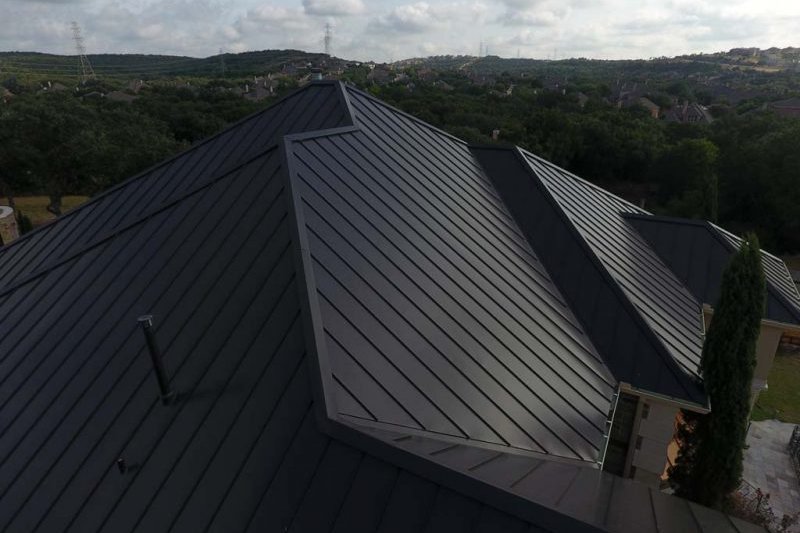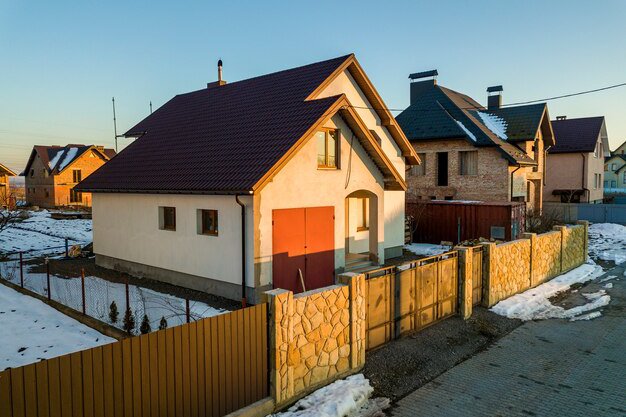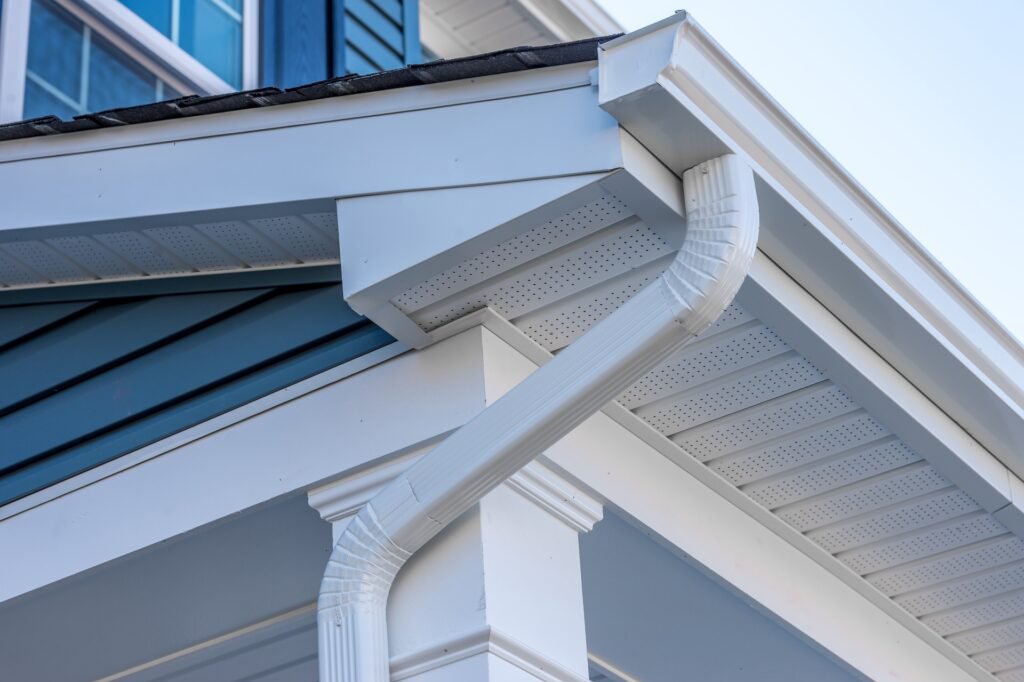Understanding Shingle Nailing: Best Practices for Roofs in Vernonia, Oregon
Your roof is your home's primary defense against the elements. In a place like Vernonia, Oregon, where weather can range from heavy rain to wind gusts, ensuring your roof is installed correctly is paramount. While shingles themselves are the visible protective layer, their effectiveness relies heavily on what lies beneath and, crucially, how they are fastened. One of the most fundamental, yet often overlooked, aspects of a durable asphalt shingle roof is the nailing pattern and the number of nails used per shingle. Getting this seemingly small detail right can mean the difference between a roof that lasts its intended lifespan and one that fails prematurely, especially in the face of challenging weather. Understanding proper nailing techniques is vital for homeowners, whether you're planning a new roof, considering repairs, or simply want to understand your existing roof's integrity. This guide delves into the specifics of shingle nailing, explaining best practices, why they matter, and how to ensure your roof is properly secured.
The Core Question: How Many Nails Per Shingle?
This is perhaps the most critical question when discussing shingle installation, and the answer comes with nuances influenced by various factors. However, the general recommendation from leading roofing manufacturers and industry standards provides a clear baseline.
For standard asphalt shingles, the recommended practice for optimal performance and wind resistance is to use six nails per shingle.
While some local building codes or manufacturer instructions for specific shingle types in low-wind areas might permit four nails per shingle, using six nails significantly enhances the shingle's resistance to wind uplift. This is particularly important in areas known for strong winds or unpredictable weather patterns. The two extra nails provide crucial additional anchoring points, distributing the load and stress more effectively across the shingle and into the roof deck.
Key Takeaway: For maximum durability and peace of mind, especially against wind, aim for six nails per asphalt shingle. While four nails may meet minimum code in some areas, six nails offer superior performance and are often required to meet enhanced wind warranty specifications from manufacturers.
Understanding why six nails are better than four involves looking at how wind interacts with a roof surface. Wind creates both positive (pushing) and negative (lifting) pressure. The negative pressure, or uplift, is what tries to peel shingles off the roof deck. More fasteners mean more resistance to this lifting force. The placement of these nails is also critical, typically within the shingle's nailing strip, ensuring they penetrate through the shingle, any underlayment, and securely into the roof deck.
Factors Influencing Shingle Nailing Requirements
While six nails per shingle is a strong recommendation for robust installation, several factors can influence or mandate specific nailing patterns and quantities. Being aware of these is important for ensuring compliance and optimizing roof performance.
Wind Zones and Local Building Codes
Building codes are developed based on regional climate data, including typical wind speeds. Areas designated as high-wind zones will have stricter requirements for roofing installation, including nailing. These codes often mandate the use of six nails per shingle and may specify additional requirements like using approved fasteners or specific types of underlayment.
Even if Vernonia, Oregon isn't classified as a severe hurricane zone, local weather patterns, including seasonal wind events, make exceeding the minimum requirements a wise decision for long-term durability. Always check with local building authorities or ensure your roofing contractor is familiar with and adheres to the specific codes for the area.
Roof Slope
The slope of your roof can also play a role, though less directly on the number of nails than on other installation aspects like underlayment. Steeper roofs shed water more efficiently, but they can also be subject to different wind dynamics than low-slope roofs. While the six-nail rule generally applies across various slopes for standard shingles, extremely low slopes (below 4:12 pitch) often require different roofing materials and installation methods altogether, where shingle nailing is not applicable.
Shingle Type
The vast majority of residential roofing uses asphalt shingles, either 3-tab or architectural (also known as laminate) shingles.
- 3-Tab Shingles: These are older, simpler shingles with a flatter appearance and three tabs per shingle strip. They are generally thinner and less wind-resistant than architectural shingles. While minimum codes might allow four nails, using six nails is particularly beneficial for 3-tab shingles to improve their wind performance.
- Architectural Shingles: These are thicker, multi-layered shingles designed to mimic the look of wood shakes or natural slate. They are inherently more durable and wind-resistant than 3-tab shingles. Manufacturer instructions for architectural shingles almost universally recommend or require six nails per shingle, especially to qualify for enhanced wind warranties.
The design of architectural shingles often includes a reinforced nailing strip, a visible area where nails should be placed to ensure proper penetration and hold.
Manufacturer Specifications and Warranties
This is a critical factor. Shingle manufacturers provide detailed installation instructions that must be followed precisely for the product warranty to be valid. These instructions will specify the number of nails, the type of nails, and their placement. To qualify for enhanced wind warranties (which often cover damage from higher wind speeds than the standard warranty), manufacturers almost always require the six-nail per shingle method.
Failing to follow manufacturer specifications, including using the wrong number of nails or improper placement, is one of the most common reasons roofing warranties are voided. Always ensure your contractor is following the manufacturer's latest installation guidelines.
The Importance of Proper Nailing: Why It Matters Beyond Just Holding Shingles On
Proper shingle nailing is far more than just attaching the shingles to the roof deck. It's fundamental to the entire roofing system's performance, longevity, and your home's protection.
Wind Resistance
As mentioned, proper nailing is the primary defense against wind uplift. High winds can work their way under shingle edges, creating suction that can lift and detach them. A sufficient number of properly placed nails distributes the forces, preventing shingles from blowing off during storms. Using six nails instead of four can significantly increase the wind speed your roof can withstand.
Shingle Lay Flat and Aesthetics
Correct nailing helps shingles lie flat and seal properly to the course below. Nails that are overdriven (driven too deep, cutting through the shingle) or underdriven (not driven deep enough, leaving the nail head protruding) can cause the shingle to buckle, cup, or not seal correctly. This not only looks bad but creates vulnerabilities where water can infiltrate.
Water Shedding
While shingles are designed to shed water, their ability to do so depends on them lying flat and forming a continuous, sealed surface. Improper nailing can disrupt this surface, creating channels or gaps where water can pool or seep under the shingles, potentially leading to leaks and deck rot.
Shingle Longevity
When shingles are properly fastened and lie flat, they are less susceptible to damage from wind, hail, and thermal expansion/contraction. This reduces wear and tear, allowing the shingles to last closer to their rated lifespan. Conversely, poorly nailed shingles can become loose, damaged, or deteriorate faster.
Warranty Validity
This cannot be stressed enough. Roofing manufacturers design their products to perform under specific installation parameters. If the installer deviates from these parameters, particularly regarding nailing, the manufacturer has grounds to deny warranty claims if the roof fails. Ensuring proper nailing is an investment in protecting your long-term investment in the roof itself.
Serious Warning: An improperly nailed roof, even if it looks okay initially, is a ticking time bomb. It is significantly more likely to fail during severe weather, leading to costly repairs or premature replacement that will NOT be covered by the manufacturer's warranty.
Common Nailing Mistakes to Avoid
Even experienced roofers can make nailing mistakes if they aren't meticulous or rush the job. Homeowners should be aware of these common errors to ensure their roof is installed correctly.
- Under-nailing: Using too few nails (e.g., four instead of six) or missing the shingle entirely. This significantly reduces wind resistance and can void the warranty.
- Over-nailing: Driving the nail too deep, causing the nail head to cut through the shingle mat. This damages the shingle, reduces its hold, and can create a point for water entry.
- Angled Nailing: Driving the nail at an angle instead of perpendicular to the roof deck. Angled nails do not have the same pull-through resistance and are more likely to back out over time.
- Misplaced Nailing: Nailing outside the designated nailing strip (on architectural shingles) or too high/low on the shingle. Nails placed too high can be exposed by the shingle above, creating a leak path. Nails placed too low may not adequately secure the shingle or could be visible.
- Using Incorrect Fasteners: Using staples instead of nails (most manufacturers require nails), using nails that are too short (not penetrating the deck sufficiently), or using the wrong type of nail (e.g., interior nails that rust). Roofing nails should be galvanized or stainless steel to resist corrosion.
- Not Nailing into the Deck: In rare cases, nails can miss the roof deck entirely, especially near edges or valleys. This shingle is essentially unsecured.
Each of these mistakes compromises the integrity of the roof system and increases the risk of failure.
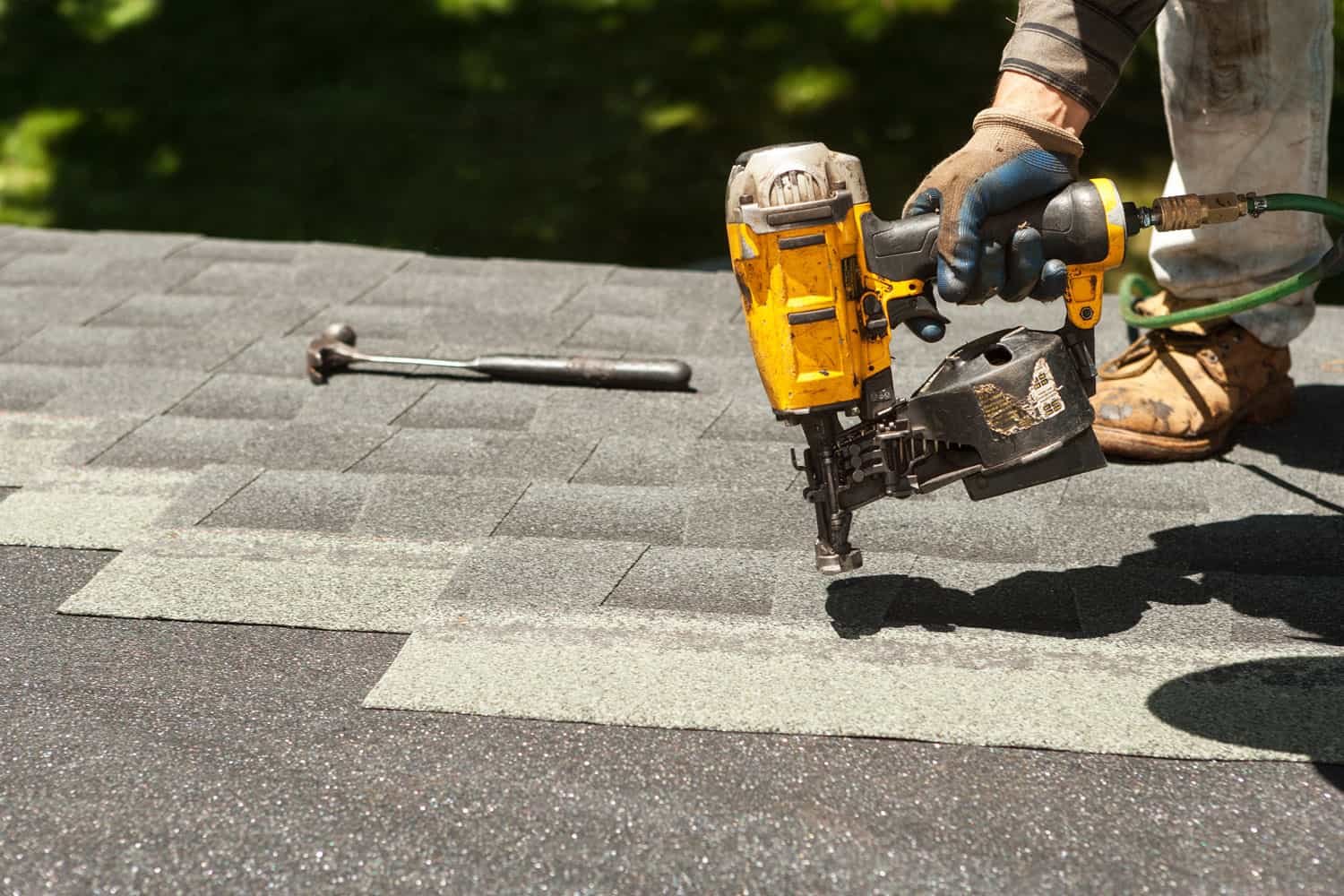
A roofer demonstrating proper nailing technique during shingle installation.
Beyond Shingles: Other Critical Roofing Components
While proper shingle nailing is vital, a complete, high-performing roof system involves several integrated components working together. Understanding these elements provides a more holistic view of your roof's structure and function.
Roof Decking
This is the foundation upon which everything else is installed. Typically made of plywood or OSB (Oriented Strand Board), the decking must be sound, dry, and properly fastened to the rafters or trusses. Damaged, warped, or rotten decking must be replaced before new roofing materials are installed. The nails used for shingles must penetrate through the shingle and underlayment and at least 3/4 inch into the roof deck for adequate hold.
Underlayment
Installed directly on the roof deck before the shingles, underlayment provides a secondary layer of protection against water penetration. Common types include asphalt-saturated felt paper or synthetic materials. Ice and water shield, a self-adhering, waterproof membrane, is often used in valleys, around chimneys, and along eaves, especially in climates prone to ice dams. Underlayment helps shed water that might get past the shingles and protects the deck during installation.
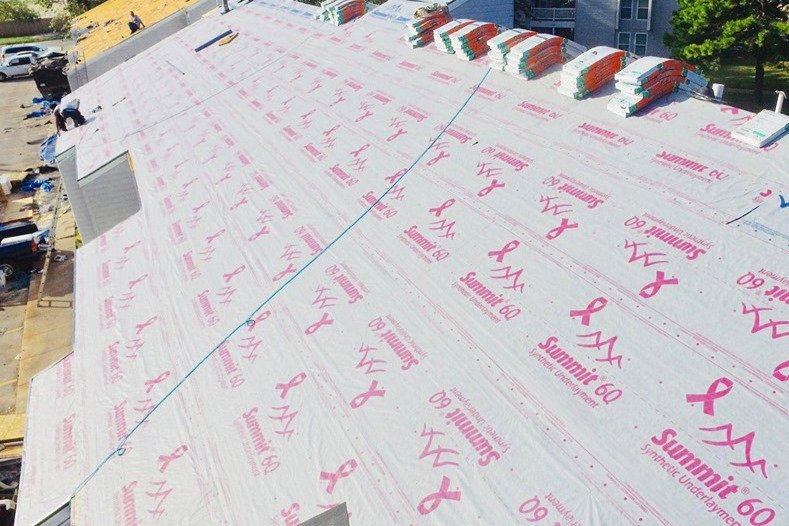
Underlayment being rolled out and fastened onto the roof deck before shingle installation begins.
Flashing
Flashing consists of metal (often aluminum, steel, or copper) or other waterproof materials used to seal transitions and penetrations on the roof where shingles alone cannot provide adequate protection. This includes areas around chimneys, vents, skylights, valleys, and wall junctions. Properly installed flashing directs water away from these vulnerable areas, preventing leaks. Poorly installed or missing flashing is a very common cause of roof leaks.
Ventilation
Proper attic ventilation is crucial for the health and lifespan of your roof and home. A balanced ventilation system, typically involving intake vents (like soffit vents) and exhaust vents (like ridge vents or box vents), allows air to flow through the attic. This helps regulate attic temperature, preventing excessive heat buildup in the summer (which can prematurely age shingles) and reducing moisture buildup in the winter (which can lead to mold, mildew, and deck rot). Proper ventilation also helps prevent ice dam formation in colder climates.
These components work together as a system. Even perfectly nailed shingles on a poorly ventilated roof or over rotten decking will not perform correctly or last as long.
Identifying Roof Issues and Seeking Professional Help
Knowing what constitutes proper shingle nailing and a healthy roof system empowers you to identify potential problems. While you shouldn't climb onto your roof unless you are trained and have appropriate safety equipment, you can often spot issues from the ground or with binoculars.
Signs of potential nailing problems or other roof issues include:
- Missing Shingles: Often a direct result of inadequate nailing, especially after wind events.
- Curling or Cupping Shingles: Can indicate aging, but can also be exacerbated by improper nailing or poor ventilation.
- Granule Loss: The protective mineral surface wearing off shingles is normal over time, but excessive loss can signal aging or damage.
- Cracked or Broken Shingles: Can be caused by impact (hail, falling debris), but brittle shingles might break more easily if improperly fastened.
- Visible Nail Heads: Nails that are underdriven or have backed out are a clear sign of improper installation or deck issues.
- Water Stains or Leaks: Stains on interior ceilings or walls, or active drips, are definitive signs that water is penetrating the roof system. This could be due to nailing issues, flashing problems, or damaged shingles.
- Sagging Roof Deck: A sign of significant water damage and deck rot, often caused by long-term leaks from compromised shingles or flashing.
If you observe any of these signs, especially active leaks or damage after a storm, it's time to seek professional help. Addressing these issues promptly can prevent more extensive and costly damage.
For urgent situations like active leaks or storm damage requiring immediate inspection by a professional, getting a qualified roofer to assess the situation quickly is essential.
Need a roofer to inspect potential damage or leaks?
Book a roofing appointment
SkyQuote can connect you with pre-vetted local roofing contractors. The process is designed for efficiency: you select the service needed (like an inspection or repair assessment), choose a convenient day, and SkyQuote handles the scheduling with an available, quality contractor in your area. This simplifies finding reliable help when you need it most, particularly for time-sensitive issues on your Vernonia, Oregon home.
Planning Your Roofing Project
Beyond urgent repairs, homeowners often undertake roofing projects as part of planned maintenance, renovations, or when the roof is nearing the end of its lifespan. Proper planning is key to a successful project. This involves understanding the scope of work, selecting materials, and, importantly, budgeting.
One of the initial steps in planning is getting an idea of the potential cost. Traditional methods involve scheduling multiple in-person inspections, which can be time-consuming. However, technology now offers more convenient options for preliminary estimates.
For non-urgent situations like budgeting for a future roof replacement, comparing costs, or getting a general estimate without needing an immediate site visit, the SkyQuote Instant Estimate service can be incredibly useful.
Curious about the cost of a new roof?
Get your free instant roof estimate
SkyQuote's instant estimate tool uses satellite imagery to measure your roof's dimensions and combines this with local pricing data for materials and labor to provide a quick, accurate quote. All you need to do is go to the link, enter your address, and the AI technology does the rest. This allows you to get a preliminary estimate from the comfort of your home, helping you with initial budget planning or comparing potential costs before engaging directly with contractors for detailed proposals or inspections.
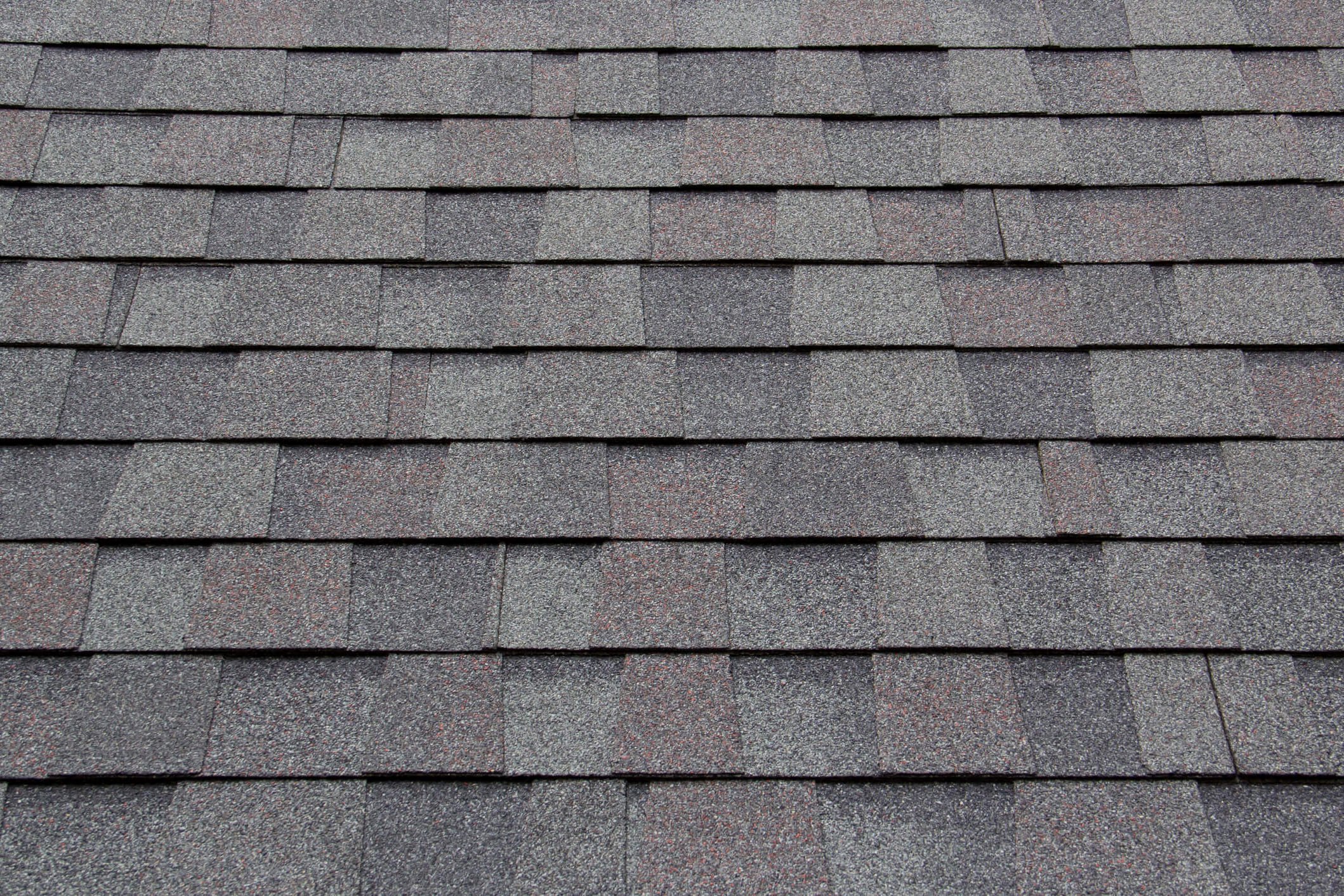
Architectural shingles, a popular choice, rely on proper nailing for their performance.
Ensuring Your Roof's Enduring Strength
The integrity of your roof hinges on the quality of its installation, and a cornerstone of that quality is proper shingle nailing. Understanding the recommendation of six nails per shingle, the factors that influence this (like wind zones and shingle type), and the consequences of getting it wrong is crucial knowledge for any homeowner. A properly nailed roof, combined with correctly installed underlayment, flashing, and adequate ventilation, forms a robust defense against the elements, protecting your home and providing peace of mind for years to come. Whether you are planning a future roofing project or need to address an immediate concern, ensuring your roof is installed to the highest standards, including meticulous nailing practices, is an investment that truly pays off in the long run.
